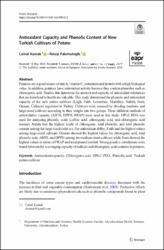Antioxidant Capacity and Phenolic Content of New Turkish Cultivars of Potato

View/
Access
info:eu-repo/semantics/embargoedAccessDate
04.02.2022Metadata
Show full item recordCitation
Kasnak, C., & Palamutoglu, R. (2022). Antioxidant Capacity and Phenolic Content of New Turkish Cultivars of Potato. Potato Research, 1-10.Abstract
Potatoes are a good source of starch, vitamin C, potassium and protein with a high biological value. In addition, potatoes have antioxidant activity because they contain phenolics such as chlorogenic acid. Studies that determine the amount and capacity of antioxidant substances that are beneficial to health are valuable. This study determined the phenolic and antioxidant capacity of the new potato cultivars (Çağlı, Fatih, Leventbey, Muratbey, Nahita, Nam, Onaran, Ünlenen) registered in Turkey. Cultivars were assessed by dividing medium- and large-sized cultivars according to their weight into two groups. Three different methods of antioxidative capacity (ABTS, DPPH, FRAP) were used in this study. HPLC-PDA was used for analyzing phenolic acids (caffeic acid, chlorogenic acid, and chlorogenic acid isomer). Nahita had the highest levels of chlorogenic, total phenolic, and total phenolic content among the large-sized cultivars. For antioxidant ability, Fatih had the highest values among large-sized cultivars. Onaran showed the highest values for chlorogenic acid, total phenolic acid, ABTS, and DPPH among the medium-sized cultivars while Nam showed the highest values in terms of FRAP and total phenol content. Strong positive correlations were found between the scavenging capacity of radicals and chlorogenic acid contents in potatoes.















